This homemade vegan Italian cannoli recipe will take you straight to Sicily, the motherland of authentic cannoli siciliani.
Our filling is made of vegan homemade ricotta and is sweet and creamy. The shell is every bit as bubbly, light, and crisp as the traditional ones, but without eggs, lard, or butter.
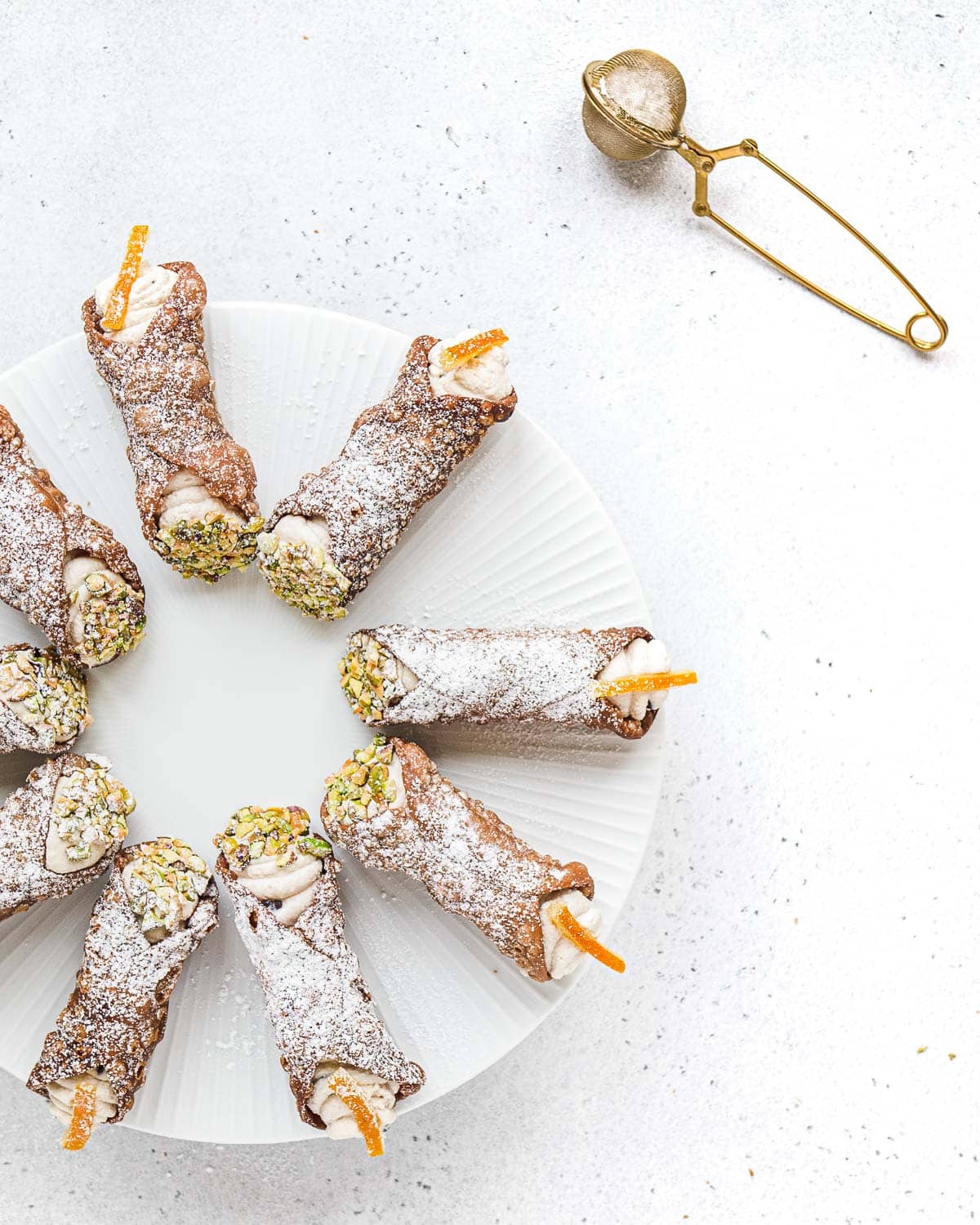
Check out our best Italian recipe collection!
What to expect
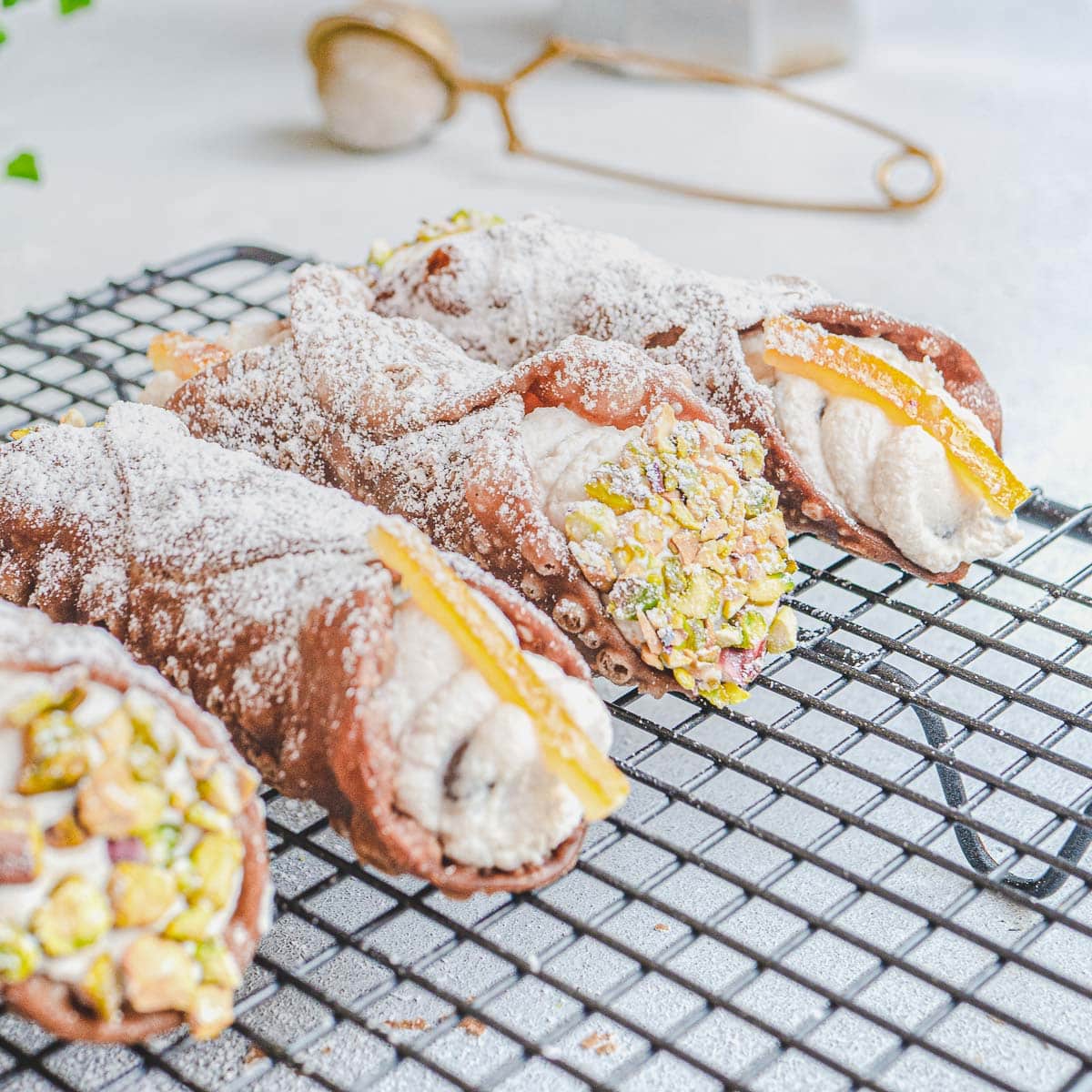
Our vegan cannoli will not disappoint. We promise. This recipe has been perfected over time to recreate the flavor and texture of authentic Sicilian cannoli.
We make the filling with our homemade soy ricotta, which is very easy to make with 3 ingredients. The ricotta flavor is neutral and mild, perfect to be used as a filling for cannoli.
The cannoli shells are also very simple and turn out crunchy and bubbly, and practically exactly like original cannoli shells. If you decide to make this recipe, you are in for a real treat.
Ingredients & Substitutions
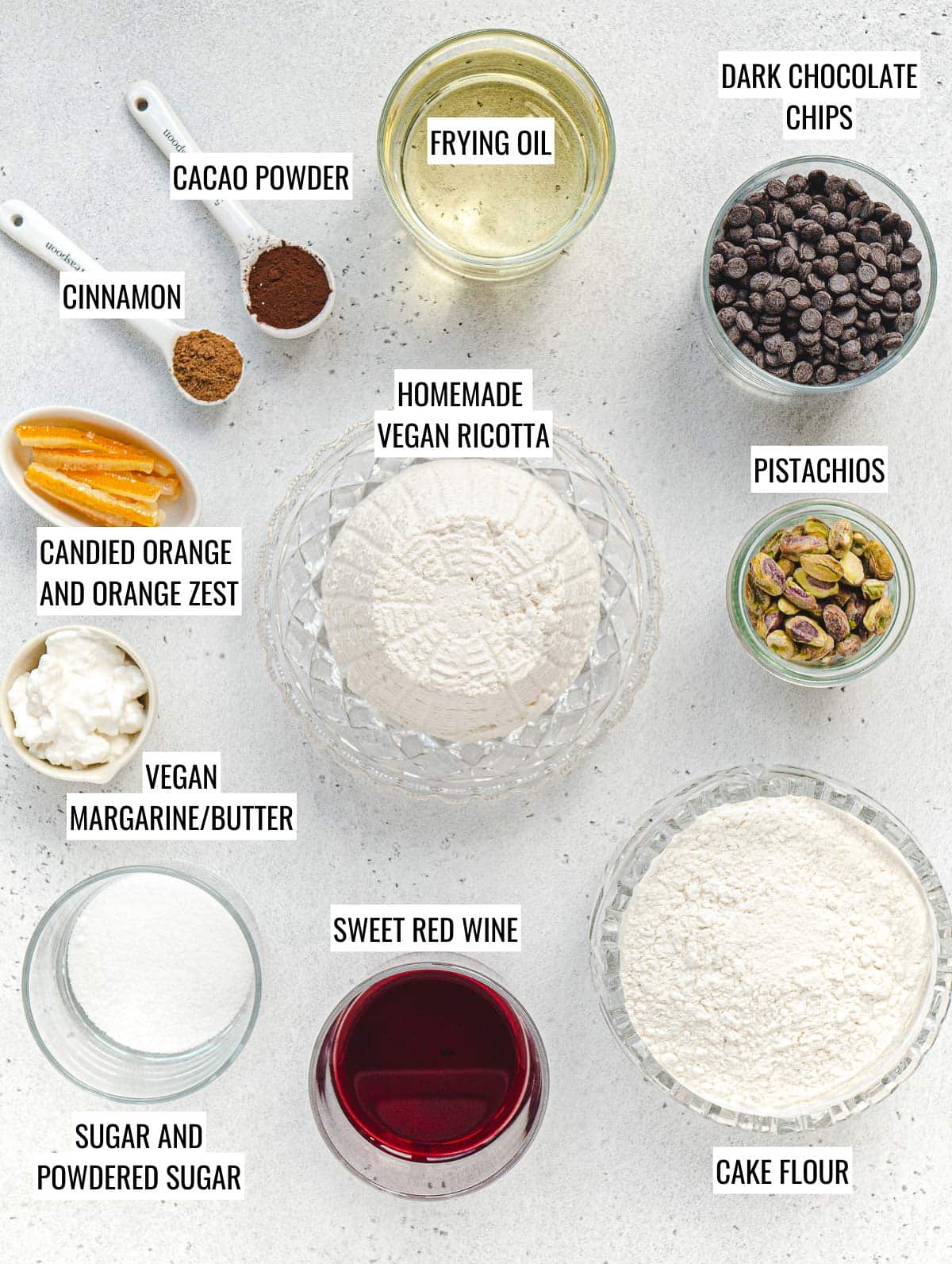
Ingredients for the vegan ricotta
- Soy milk: we tested over 25 brands of soy milk and they all worked to make this ricotta. For this recipe, you can use either sweetened or unsweetened soy milk.
- Vinegar: regular white vinegar, apple cider vinegar, or lemon juice.
- Salt: to neutralize the flavor of the vinegar.
Ingredients for the vegan cannoli filling
- Vegan ricotta.
- Sugar: use regular white sugar for authentic cannoli taste and texture. You could replace it with other sweeteners, like brown sugar, or syrups.
- Dark chocolate chips: get the small ones that look like little drops.
- Grated orange zest: in some Sicilian recipes you find orange zest, in others you don’t. We like to add some.
Ingredients for the vegan cannoli shell
- Flour: use cake flour to get a shell that is light and crisp like the traditional cannoli shell. You could replace it with other less refined flours.
- Sugar: we use regular sugar.
- Fat: we use our homemade margarine for this recipe. We make it by blending together 100 ml of sunflower seed oil and 50 ml of soy milk. You can also use store-bought margarine or vegan butter.
- Marsala or wine: marsala, a fortified Sicilian wine, is used in most authentic Sicilian cannoli recipes. But marsala is hard to find outside of Italy. Some people use wine, sometimes red, sometimes white, depending on the local tradition in Sicily. We tested all recipes, and our best result was sweet red wine. It’s easier to find than marsala, it’s cheaper, and it yields a great result making the shells light and full of bubbles.
- Cacao powder and cinnamon: we use them to give color and aroma to the dough.
- Oil for frying: in the traditional cannoli recipe, people fry the cannoli in lard. Since our cannolis are vegan, we do them without lard, and instead, we fry them in vegetable oil. We use sunflower or peanut oil.
Ingredients for the cannoli toppings
- Pistachios: unsalted and crushed.
- Candied orange peel: you can also add candied cherries.
- Powdered sugar: used to sprinkle on top, makes the cannoli extra cozy and delicious.
Equipment
- Cheesecloth: to filter the ricotta. You can replace it with a clean and white kitchen cloth. Just make sure it doesn’t smell like washing detergent.
- Cannoli forms/tubes: you can find them on amazon. You can replace them with homemade tubes, made with rolled aluminum paper, wrapped in parchment paper. But it’s going to be a bit of a project, you’ve been warned 🙂
- Round pastry cutters: you can replace them with a knife.
- Pastry piping bag: to help you fill the cannoli, you can also use a spatula.
- Rolling pin: you could use a pasta-making machine to roll the dough, but we prefer the rolling pin.
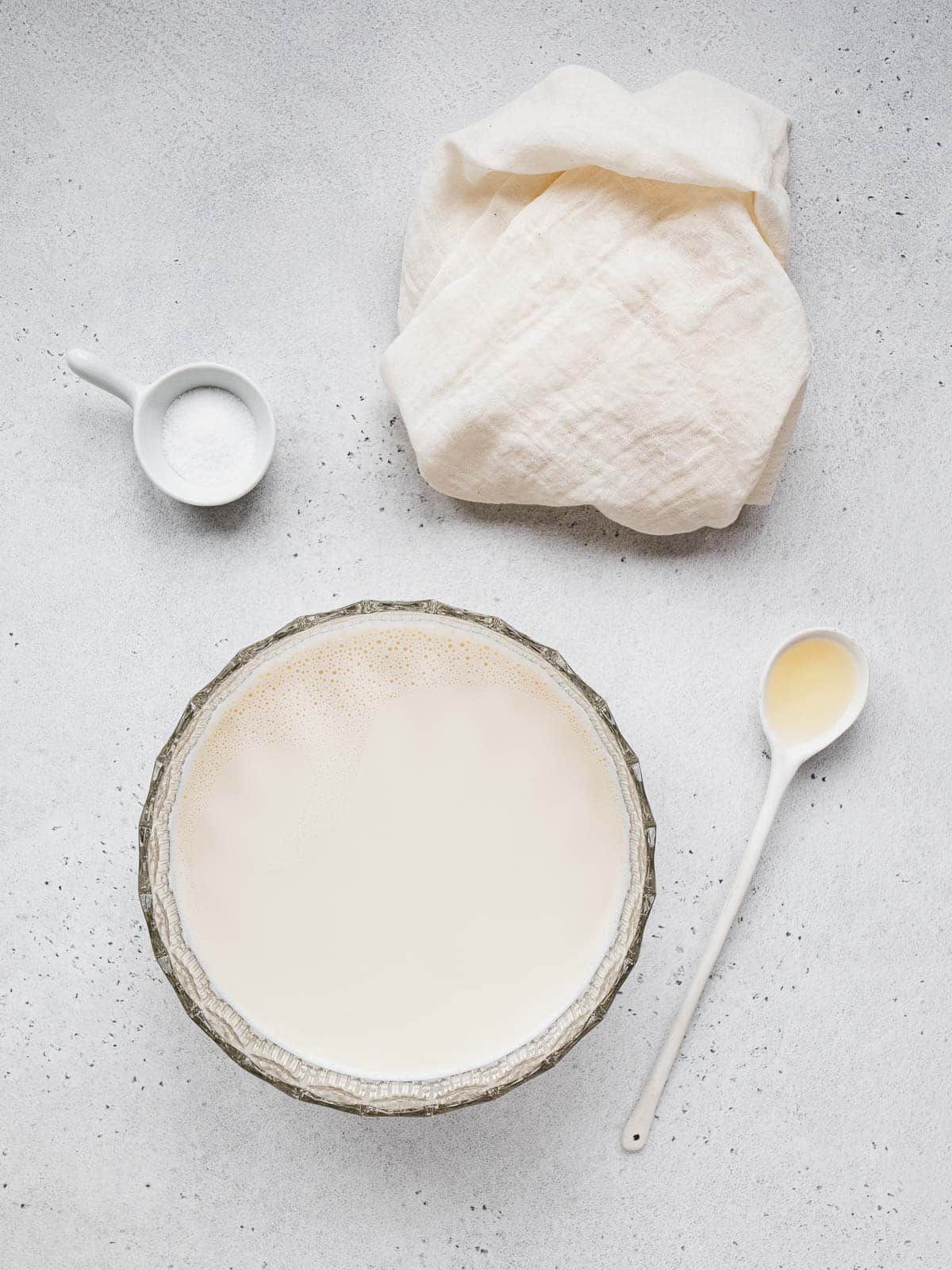
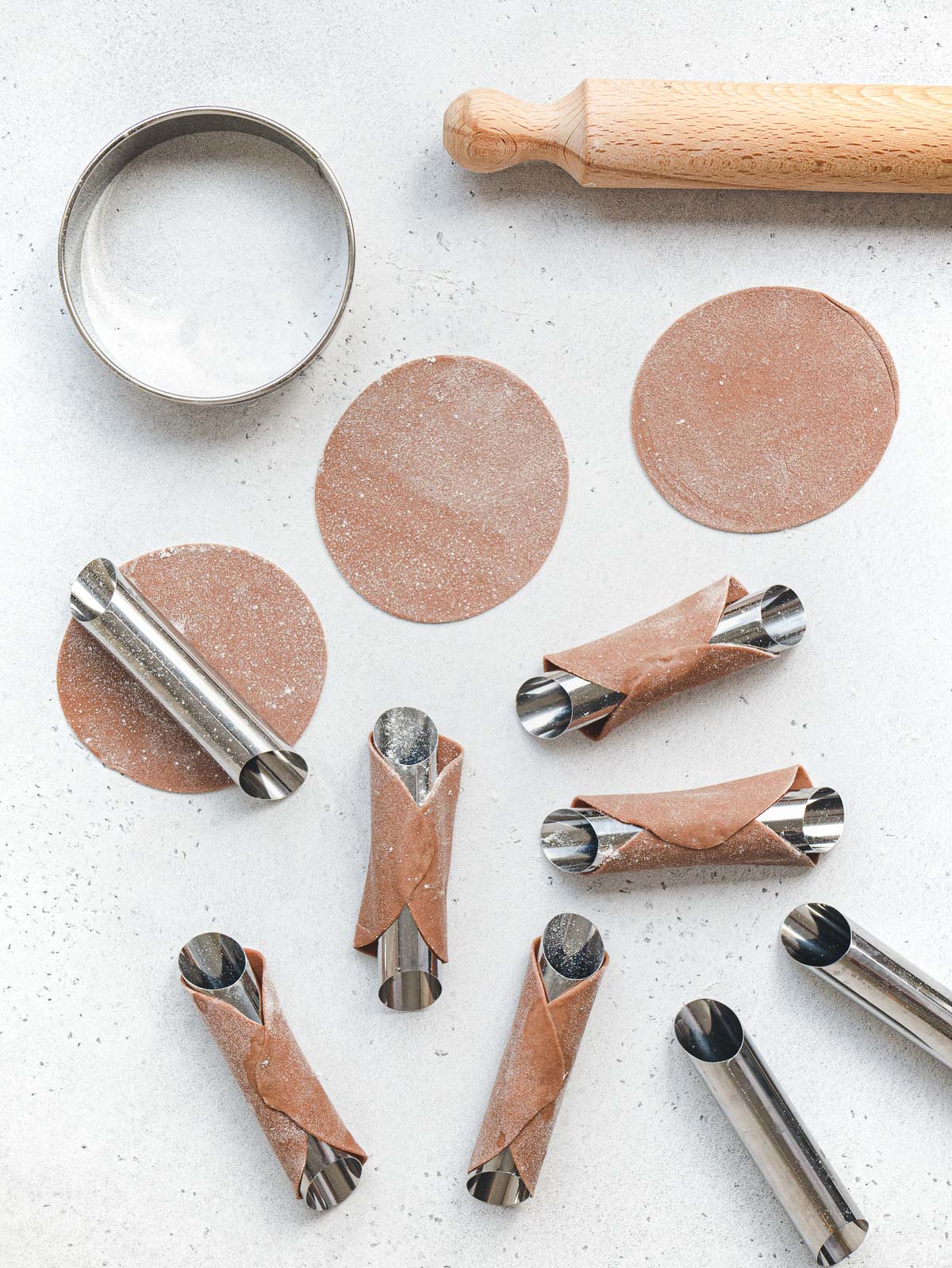
Instructions
Make the cannoli shells
For this cannoli recipe, we start by making a simple dough. To do that, add flour, sugar, cacao powder, and cinnamon to a bowl and mix well with a spatula. Now add softened vegan butter (or margarine), the marsala wine (or sweet red wine), and the water. Mix with a spatula till you have a dough ball.
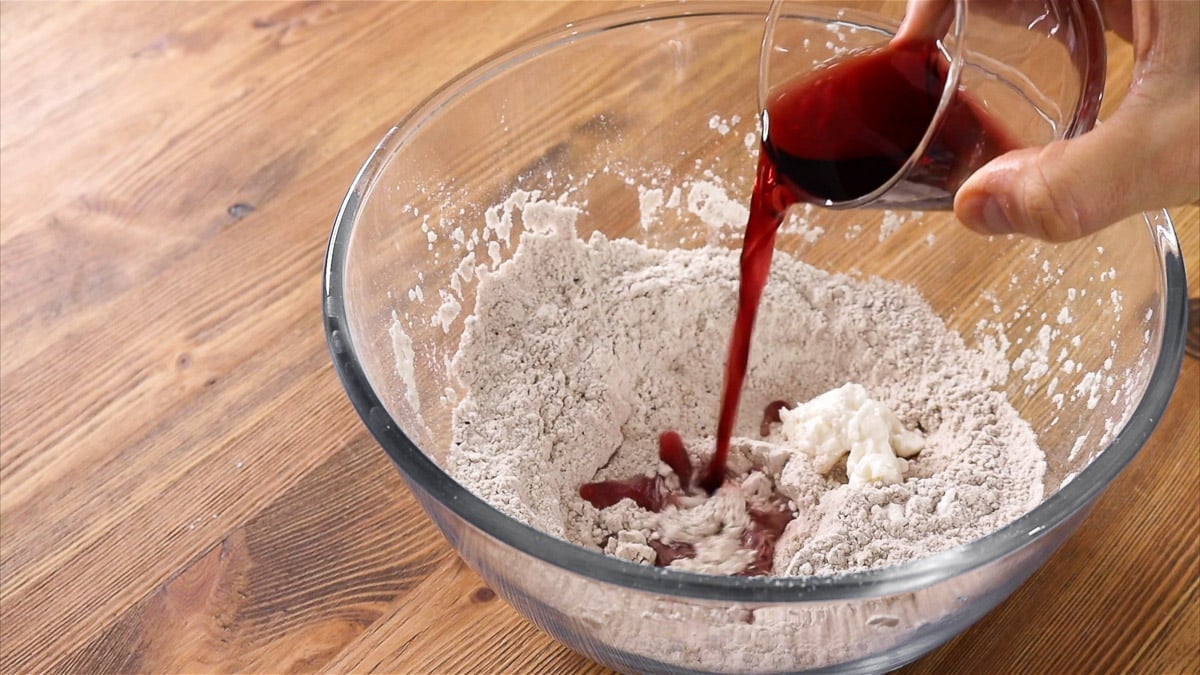
Then, on a worktop, knead the dough ball for about 5 minutes. You should have a smooth dough ball, with a soft consistency, but not sticky. If it’s too wet and sticky, add some flour to the worktop and keep kneading until it doesn’t stick to your hands.
Now you can let it rest in a bowl, covered with a plate, for 30 minutes. TIP: when resting, the gluten in the dough relaxes, making it easier for you to roll, and lighter to eat.
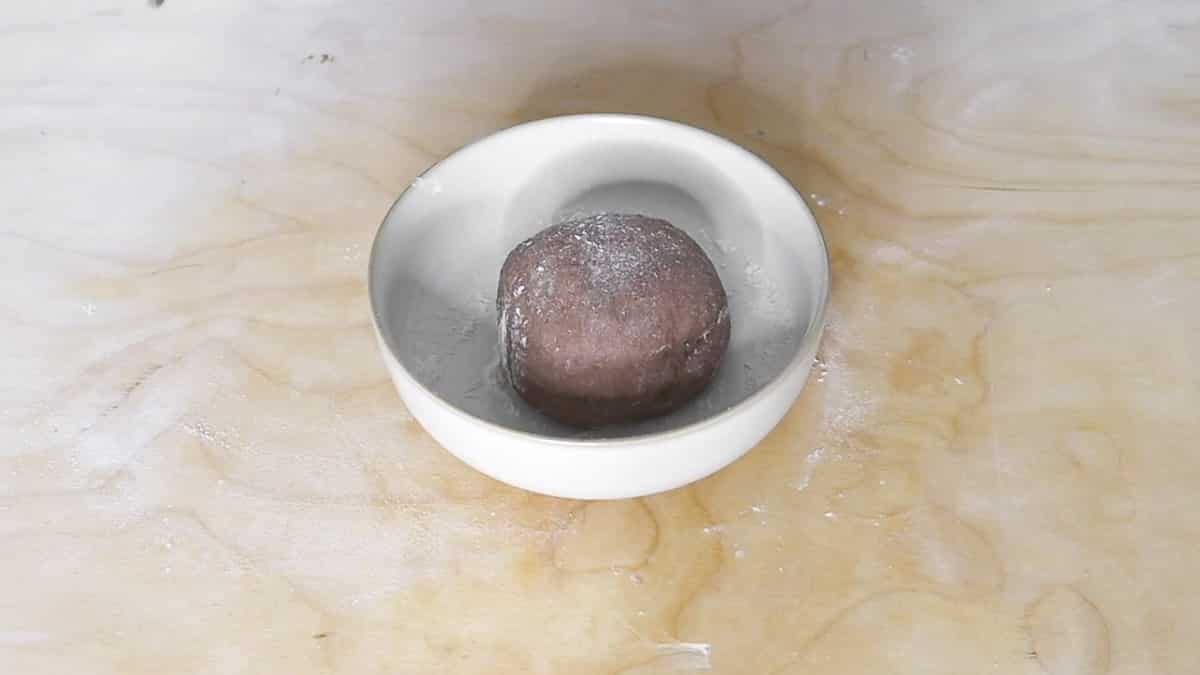
After 30 minutes of resting, you can start rolling the dough with a rolling pin. Dust the worktop and the rolling pin with flour to prevent the dough from sticking.
While rolling, fold the dough on itself 5 to 10 times before flattening it completely. This will make the cannoli shell lighter and full of little bubbles. You should aim for a thin dough, of about 1 to 2 millimeters.
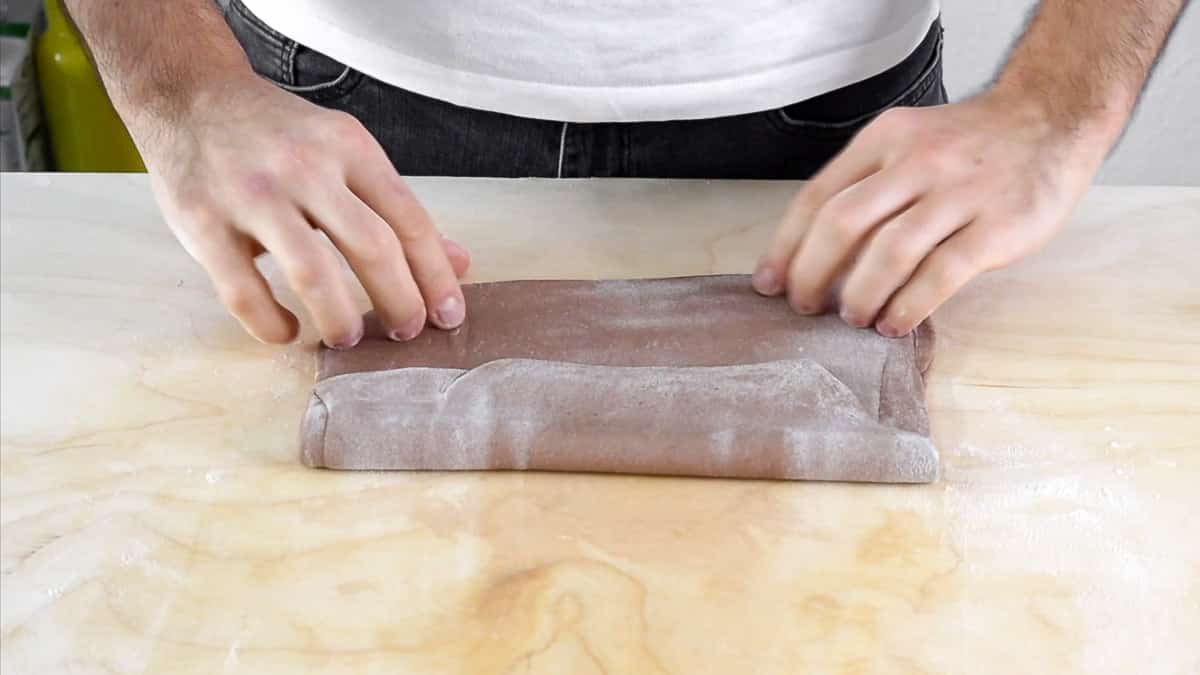
Now cut the dough into squares or circles, of the length of the cannoli tubes and wrap the cut dough around the cannoli tubes. Then wet the edges with some water before sealing the cannoli dough. Make sure the cannoli are well sealed, or they’ll open up while frying.
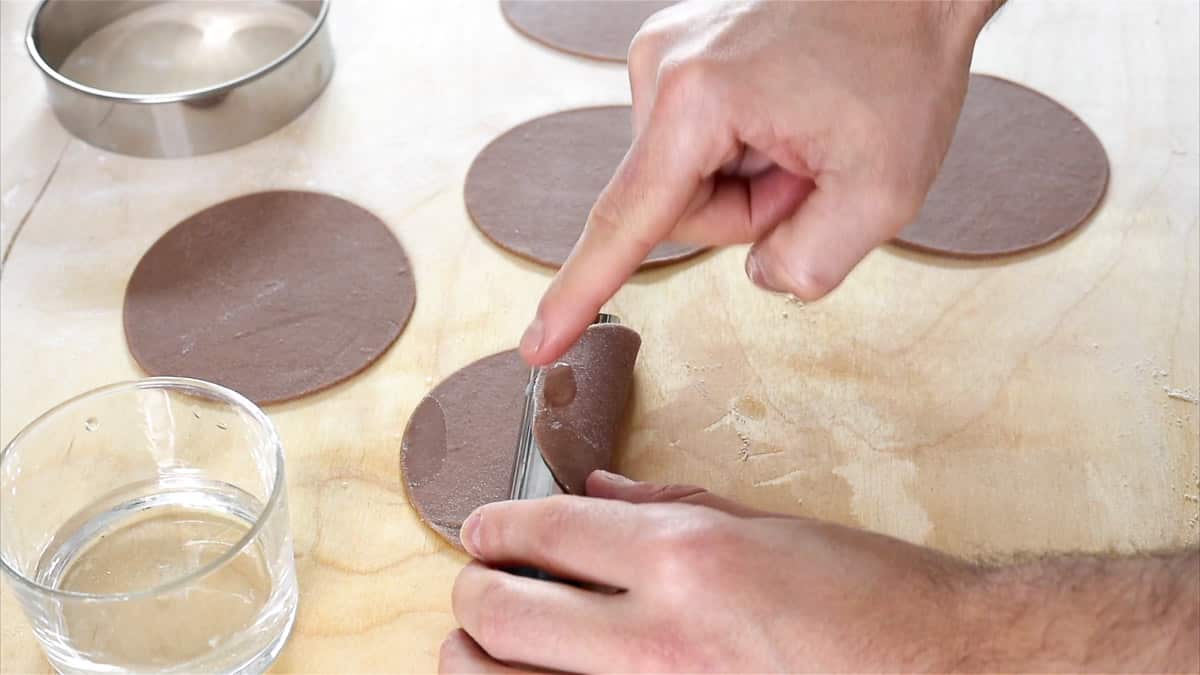
Fry the cannoli shells
Before you start frying, remember that hot oil and water should never come into contact. So please be careful. Now, add the frying oil to a pot. Don’t fill the pot with oil completely, only half. The pot should be small, but big enough to comfortably fit one cannoli plus the frying oil.
Bring the oil to temperature. It should reach 180°C (360°F). The best way to check if the oil has reached temperature is with a thermometer. If you don’t have one, dip the tip of a wooden spoon in the oil. When it starts to bubble, the oil is ready. If the oil smokes, it means it is too hot, and it’s burning. That’s not healthy.
TIP: make sure the temperature of the oil stays at around 180°C (360°F). If it’s too low, the shells will absorb oil. If it’s too high, the shells will burn.
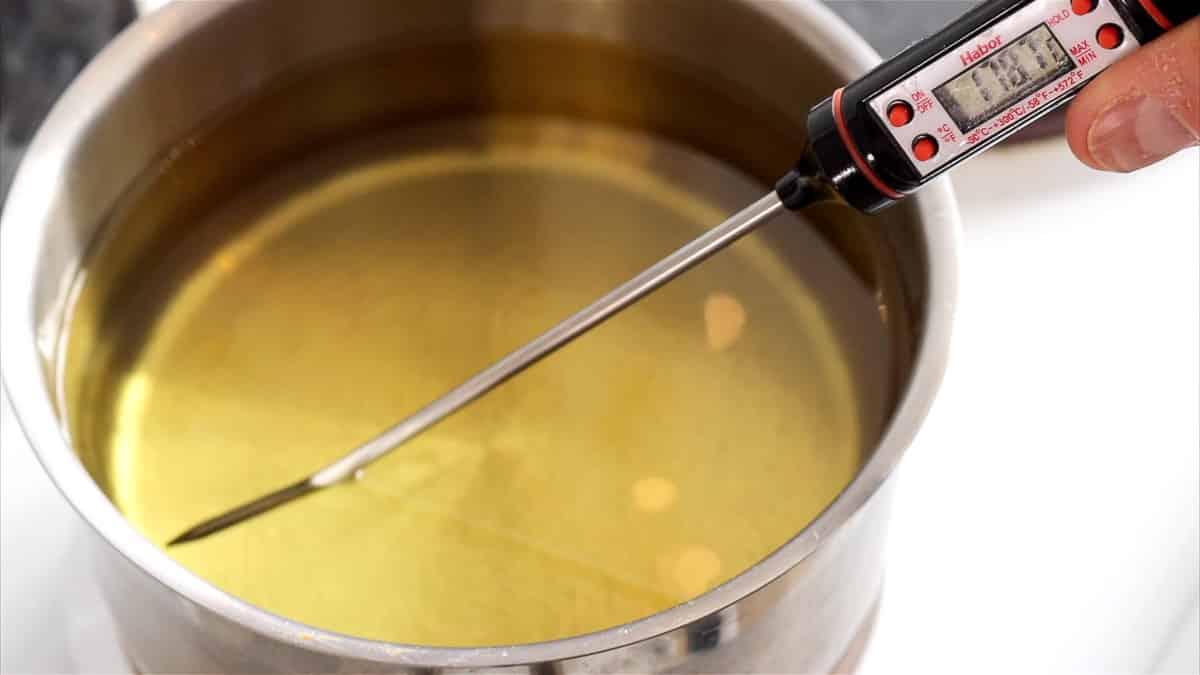
Now you can fry the cannoli, one by one. It takes about 1 minute for each cannolo. Turn them around while frying so that they cook evenly.
TIP: if you see that the cannoli break away from the forms while frying, then give the next ones a squeeze with your hands to tighten them up around the forms, before dipping them in the frying oil.
When the cannoli turn light brown, take them out of the oil, let drip the excess oil, and place them on a cooling rack on some kitchen paper. They’ll darken when cooling.
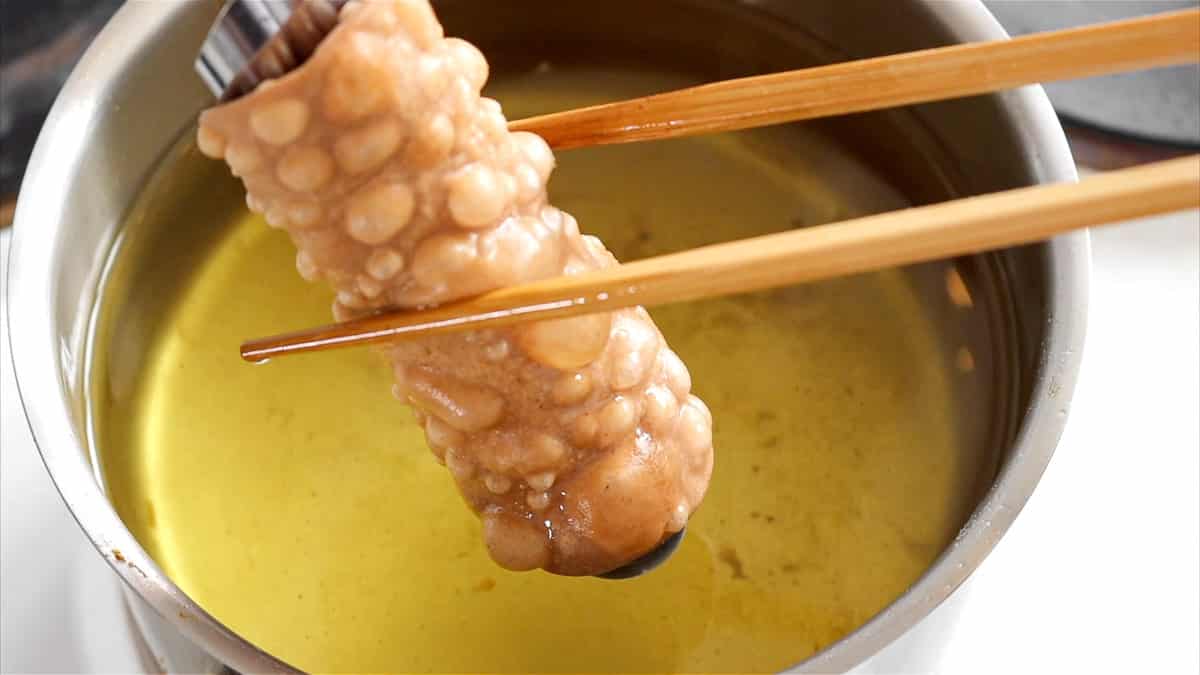
When cooled, gently remove the forms and get ready to fill up the cannoli shells. Only fill up the shells once they are completely cooled.
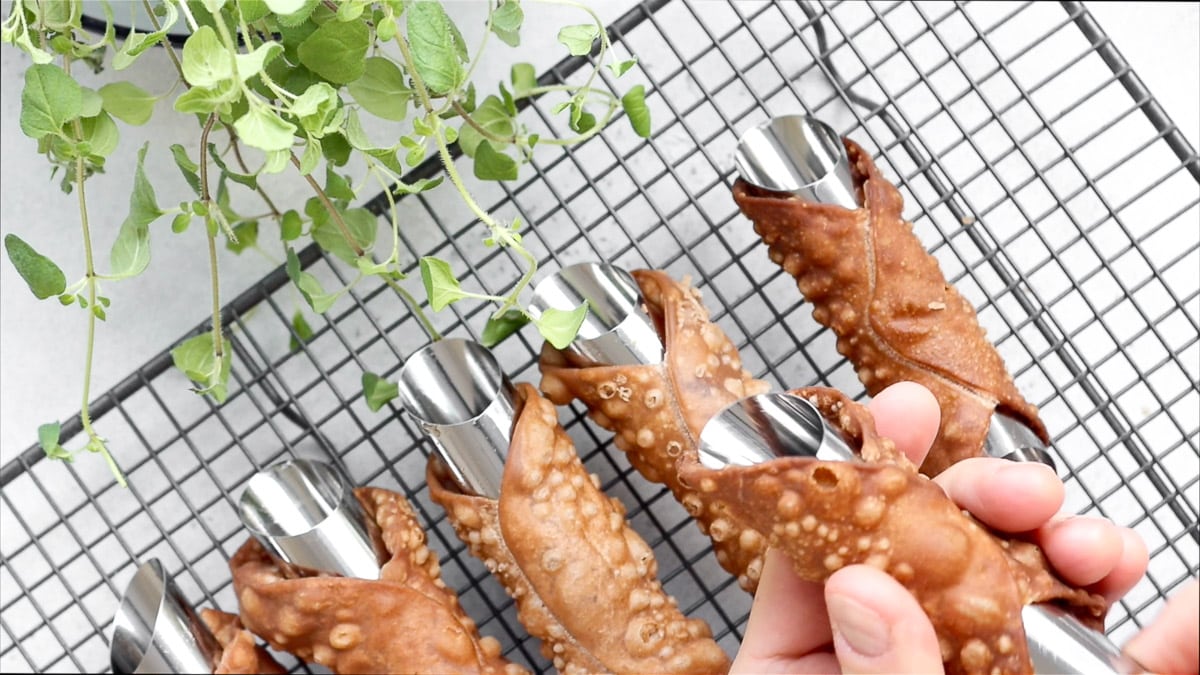
Make the cannoli filling
In a bowl, add the vegan ricotta, sugar, vegan dark chocolate drops, and a tiny bit of orange zest. Use a spatula to gently mix. Do not over-mix.
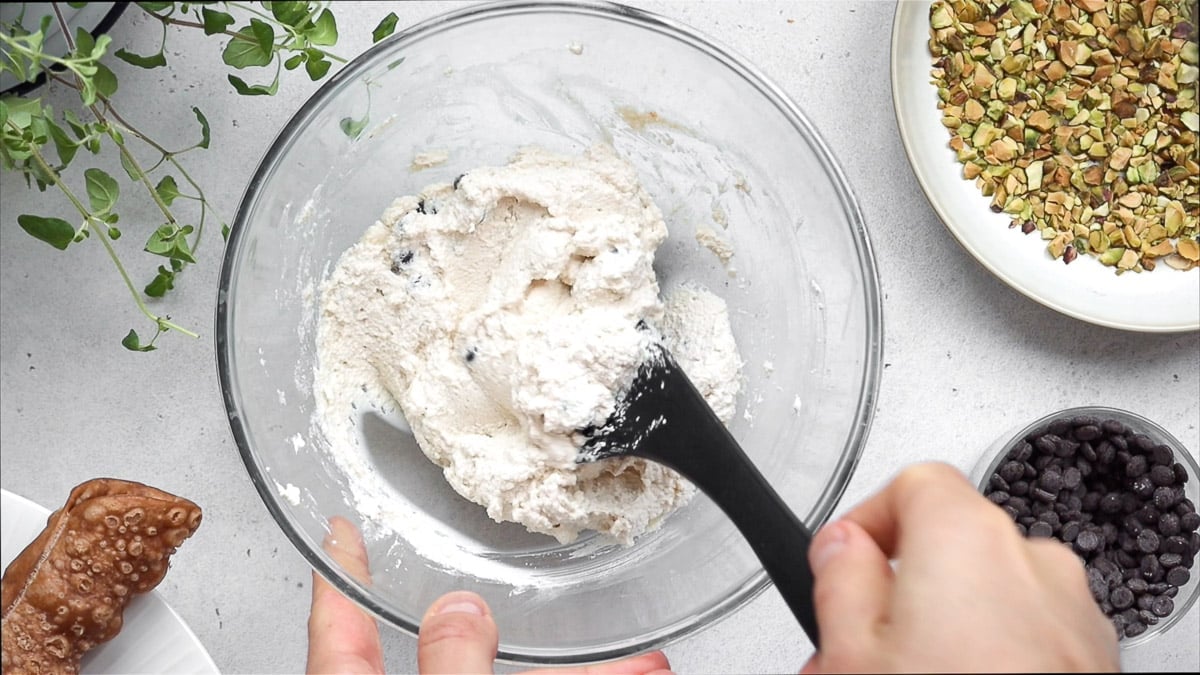
Put the ricotta cream into a pastry piping bag and start filling the cannoli one by one. Fill each cannolo from both sides, starting from the middle and moving outwards, while filling.
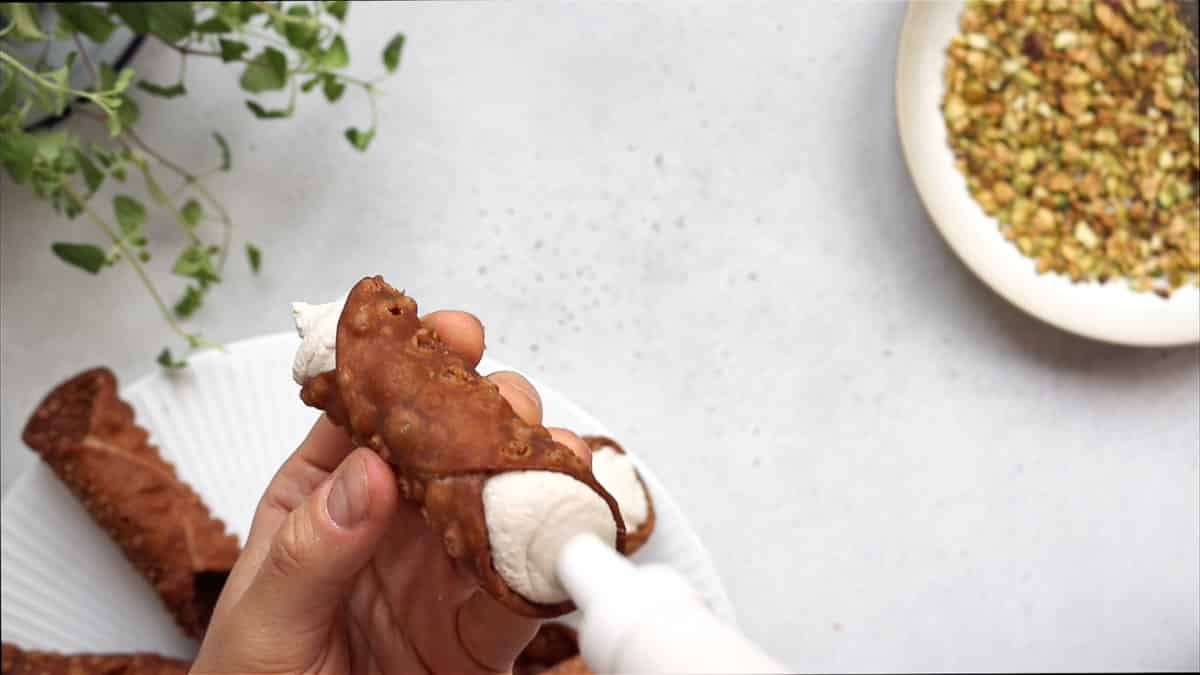
Dip one end of the cannoli into some crushed pistachios, and top the other end with candied orange peel or half a candied cherry.
Arrange on a serving platter, sprinkle with powder sugar and enjoy.TIP: Use the leftover dough to make some cannoli nachos. Flatten it, then cut it into triangles, fry it, and serve it with a side of cannoli filling dip. See our variations section.
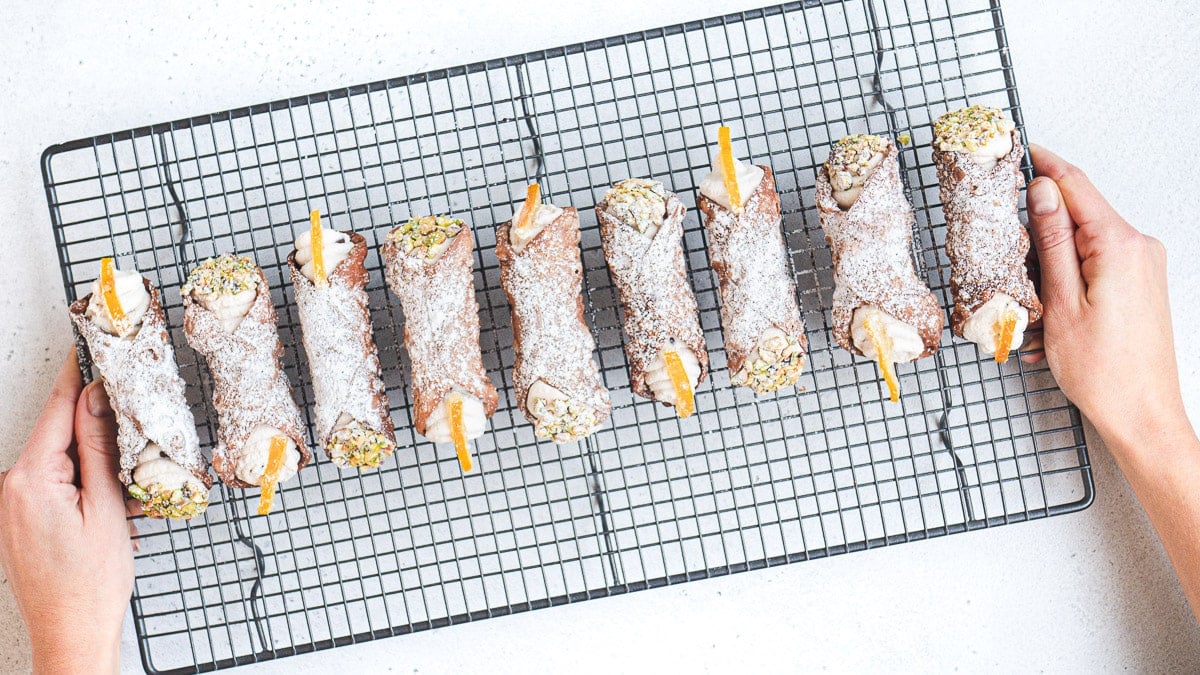
Tips
- Drain the ricotta well: drain the ricotta for about 30 minutes with a weight on top so that the ricotta is drier and the cannoli shell doesn’t get soggy. I use a bowl filled with water to add weight.
- Fold the dough: a tip to make a light, crisp and bubbly dough, is to fold it several times while rolling it. Do that 5 to 10 times and you will get a vegan cannoli shell that is as delicious, light, and crisp as the nonvegan one.
- Roll it thin: roll the dough for the cannoli shell 1 millimeter thin if you can. You can do so with the help of a pasta machine, or simply with a rolling pin. Doing so will produce a cannoli shell that will fry faster, will be lighter, and absorb less oil.
- Seal them well: admittedly my first cannoli shell was a disaster. It opened up completely while frying. To avoid that mistake, seal the edge of the cannoli with a bit of water, then lightly squeeze the dough around the cannoli tube with your whole hand.
- Fill just before serving: if it stays too long in the shell, the filling will make the cannoli soggy. So fill them up at the last minute, just before eating them.

Questions
Traditional cannoli filling is made of “ricotta di pecora”, a soft Italian cheese made of curdled sheep’s milk. Our vegan cannoli filling is made of curdled soy milk. Trust us, it’s as delicious, if not better, than the traditional ricotta.
You can use bamboo canes or rolled-up aluminum foil, wrapped in parchment paper.
Yes. You can make vegan Italian cannoli without lard as we do in our recipe. Just use margarine, vegan butter, or regular vegetable oil like sunflower seed oil.
Yes. You can replace wine with half water, half vinegar. We recommend adding either wine or vinegar to make your cannoli shells bubble, just like the authentic Sicilian cannoli recipe.
Variations
- Chocolate shell cannoli: dip the edges of the cannoli shell into melted dark chocolate, let it cool, and then fill it up. Delicious! If you are extra indulgent, you can even dip the whole cannoli shell into the chocolate, let cool on a cooling rack, and then fill it up with regular filling. This is going to be messy, but worth it.
- Cannoli nachos: this is by far our favorite variation and one that we make every time. We make it with cannoli dough leftovers. Put all the dough leftovers together, then roll them thin, and cut them into small nachos-like triangles. Deep fry them for like half a minute, and serve next to a bowl of cannoli filling. OMG, this one is just so good!
- Change up the nuts: you can swap the pistachios with almonds or hazelnuts if you prefer.
PSST! If you’re also a big fan of vegan Italian recipes, we hear you! If we missed one of your favorite Italian recipes on our site, let us know in the comments below. Comments and ratings help us improve our content, so leave us a note below if you like what we do ❤️

Storage
Cannoli that have been already filled with the ricotta filling don’t store well, as the filling makes the shell moist and they will become soggy. So if you have filled cannoli leftovers, store them for a max of 3 hours in the refrigerator.
The best way to store cannoli is to keep the shells and the filling separate. Store the shells for up to 4 days in a dry corner of your kitchen, covered with a cloth. Do not store them in the refrigerator as they’ll get soggy.
Store the vegan cannoli filling in an airtight container in the refrigerator for up to 4 days. The filling might turn slightly off-white with time, but don’t worry, it’ll taste fine.
Similar recipes
If you’re also a fan of plant-based desserts, check out these delightful sweets:
- Italian chiacchiere
- Vegan donuts
- Vegan lemon cake with lemon curd
- Vegan vanilla cake
- Soft orange curd cake
- Easy orange cake with orange curd filling
- Carrot and orange cake
- 7-ingredient vegan apple cake
Do you have a favorite sweet that we haven’t made yet? Let us know in the comments below, we’d love to hear!

Vegan Cannoli Recipe
Equipment
- Cheese cloth or clean kitchen cloth to make the ricotta
- Cannoli tubes
- Rolling pin
- Pastry cutter or a sharp knife
- Pastry piping bag optional
Ingredients
For the homemade vegan ricotta (you should get around 23oz / 630g)
- ¾ gallon soy milk
- 6 tablespoons vinegar
- 1 teaspoon salt to neutralize the vinegar flavor
For the cannoli filling
- 23 ounces vegan ricotta
- 5 tablespoons sugar
- 4 tablespoons dark chocolate chips
- ½ teaspoon grated orange zest
For the cannoli shells
- 1½ cups cake flour
- 2 tablespoons sugar
- 2 tablespoons vegan butter or margarine (softened)
- 4 tablespoons sweet red wine or marsala
- 1 tablespoon water
- 1 teaspoon dark cacao powder
- ½ teaspoon cinnamon
- 5 cups frying oil
For the toppings
- 6 tablespoons pistachios coarsely chopped
- 16 pieces candied orange peel
- 1 tablespoon powdered sugar
Instructions
Prepare the vegan ricotta
- Put the soy milk into a large pot and bring it to a boil while stirring. Turn the heat off as soon as the milk boils, then add the salt and vinegar.
- Stir with a spoon for 1 minute, then set aside for 10 minutes. During this time you should be able to see the soy milk curdle.
- In the meantime, place a strainer onto a large bowl or pot. Cover the strainer with a clean kitchen cloth, made of cotton and with a fine mesh (or a cheesecloth).Tip: make sure the cloth doesn't smell like detergent.
- After 10 minutes, pour the curdled soy milk into the strainer.
- Now wrap the curdled milk in the cloth, put a weight on top (like a bowl filled with water) and let it drain for about 15 to 30 minutes. Note that the longer it drains, the drier the vegan ricotta. I drain mine for 30 minutes.
- After draining, the ricotta is ready to be used for both sweet (such as cannoli or pies) and savory (such as lasagna, ravioli with spinach, cannelloni, stuffed shells) dishes.
Prepare the cannoli shells
- While the ricotta is draining, to a bowl, add flour, sugar, cacao powder, cinnamon and mix well.
- Add softened vegan butter (or margarine), the marsala wine (or sweet red wine), and the water. Mix with a spatula till you have a dough ball.
- On a worktop, knead the dough ball for about 5 minutes. You should have a smooth dough ball, with a soft consistency, but not sticky. If it's too wet and sticky, add some flour to the worktop and keep kneading until it doesn't stick to your hands. Let rest in a bowl, covered with a plate, for 30 minutes.TIP: when resting, the gluten in the dough relaxes, making it easier for you to roll out, and lighter to eat.
- Then with a rolling pin start rolling out the dough. Dust the worktop and the rolling pin with flour to prevent the dough from sticking. You should aim for a thin dough, of about 1 to 2 millimetres (0.04 to 0.08 inches).
- Fold the dough on itself several times (5 to 10 times) before flattening it completely. This will make the cannoli shell lighter and full of little bubbles.
- Cut the dough into squares or circles, of the length of the cannoli tubes.
- Wrap the cut dough around the cannoli tubes, then wet the edges with some water before sealing the cannoli dough. Make sure the cannoli are well sealed, or they'll open up while frying.
- Add the frying oil to a pot. The pot should be small, but big enough to comfortably fit one cannolo plus the frying oil.
- Bring the oil to temperature. It should reach 350°F (180C). The best way to check if the oil has reached temperature is with a thermometer. If you don't have one, dip the tip of a wooden spoon in the oil. If it's starts to bubble, the oil is ready. If the oil smokes, is too hot, and it starts burning. That's not healthy.TIP: make sure the temperature of the oil stays at around 350°F(180C). If it's too low, the shells will absorb oil. If it's too high, the shells will burn.
- Fry the cannoli, one by one. It takes about 1 minute for each cannolo. Turn them around while frying so that they cook evenly.TIP: if the cannoli break away from the forms, give them a squeeze with your hands to tighten them up around the forms, before dipping them in the frying oil.
- When the cannoli turn light brown, take them out of the oil, let drip the excess oil, and place on a cooling rack on some kitchen paper. They'll darken when cooling.
- When cooled, remove the forms and get ready to fill up the cannoli shells. Only fill up the shells once they are completely cooled.
Make the ricotta filling
- In a bowl, add the vegan ricotta, sugar, dark chocolate chips, and a tiny bit of orange zest. Use a spatula to gently mix. Do not overmix.
- Put the ricotta cream into a pastry piping bag and start filling the cannoli one by one.
- Fill each cannolo from both sides, starting from the middle and moving outwards, while filling.
- Dip one end of the cannoli into some crushed pistachios, and top the other end with candied orange peel, or half a candied cherry.
- Arrange on a serving platter, sprinkle with powder sugar and enjoy.TIP: Use the leftover dough to make some cannoli nachos. Flatten it, then cut it into triangles, fry it, and serve it with a side of cannoli filling dip. See our variations section.
Nutrition
If you liked this cannoli recipe, you might also like:
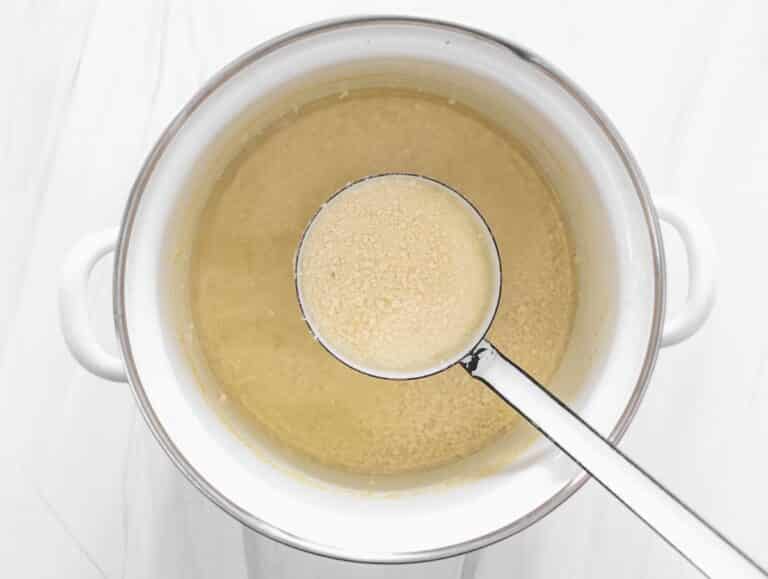
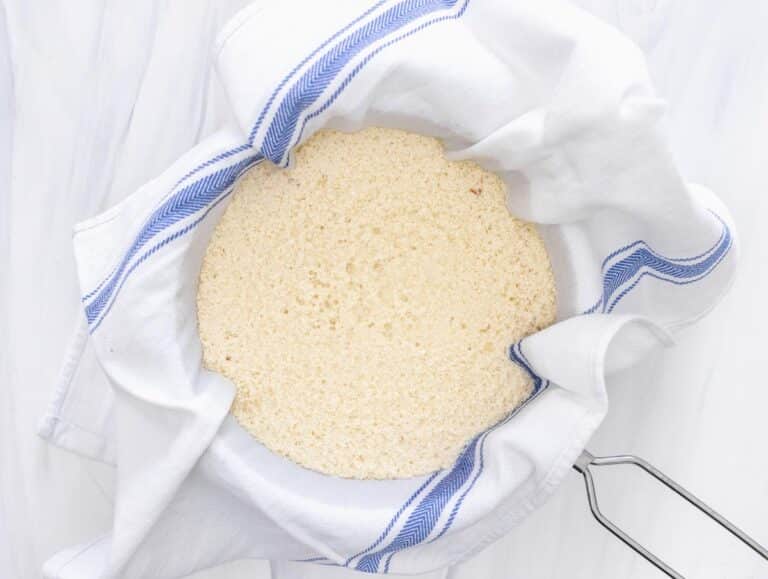
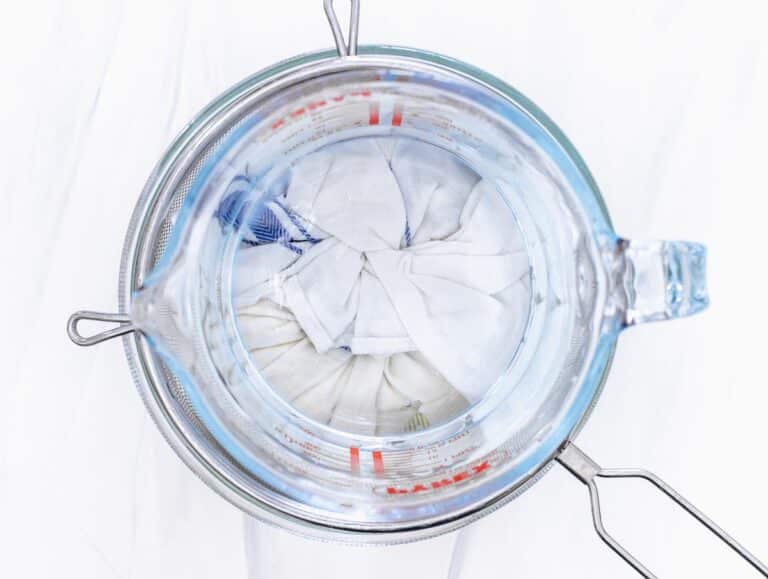
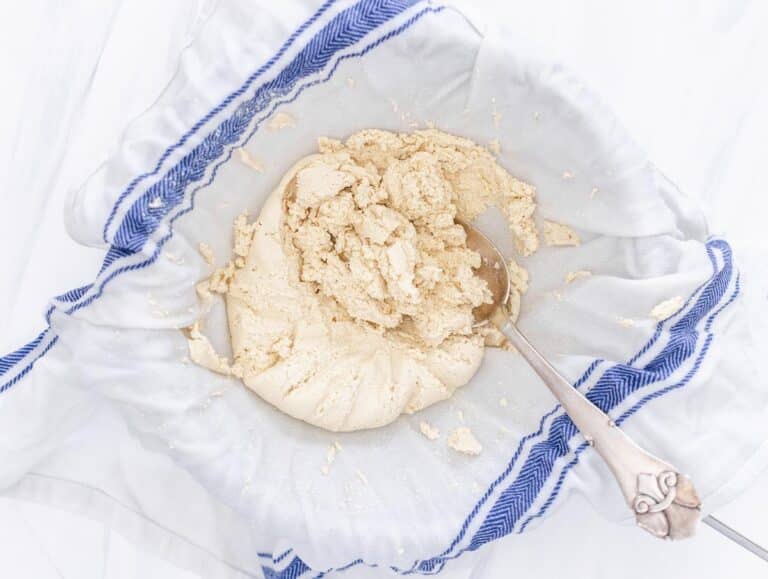
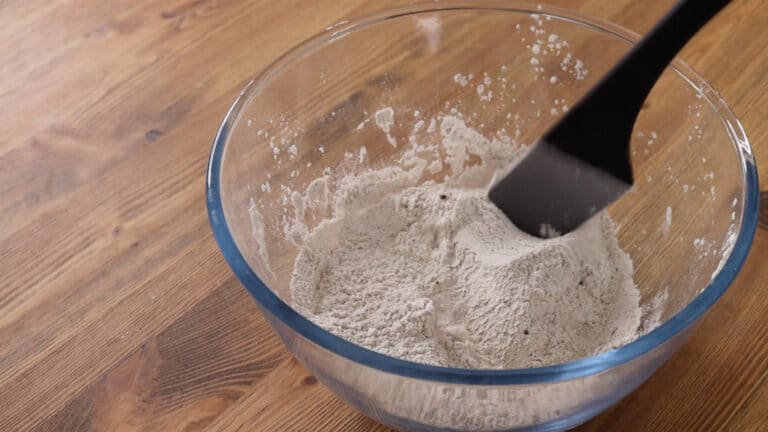
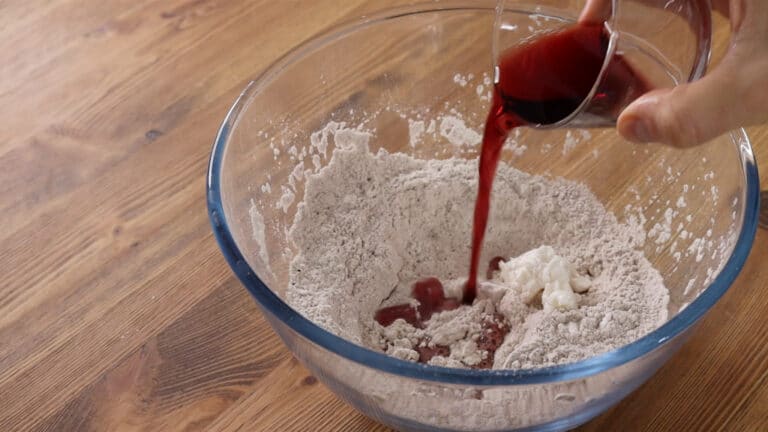
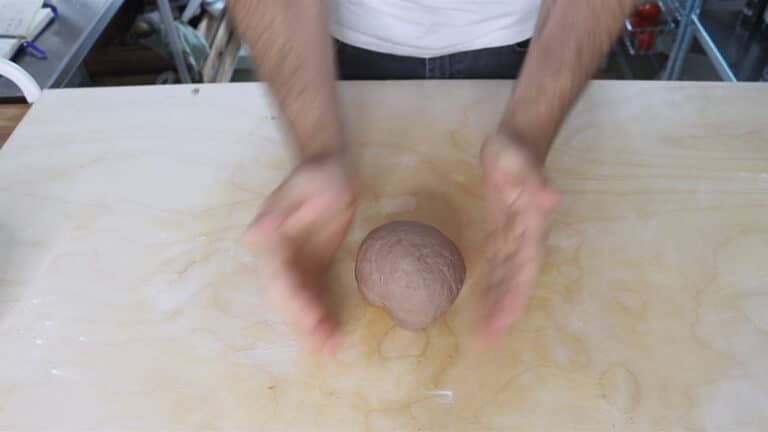
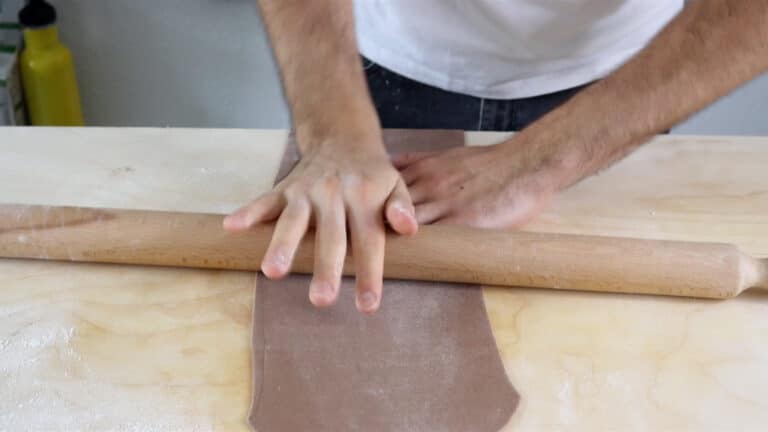
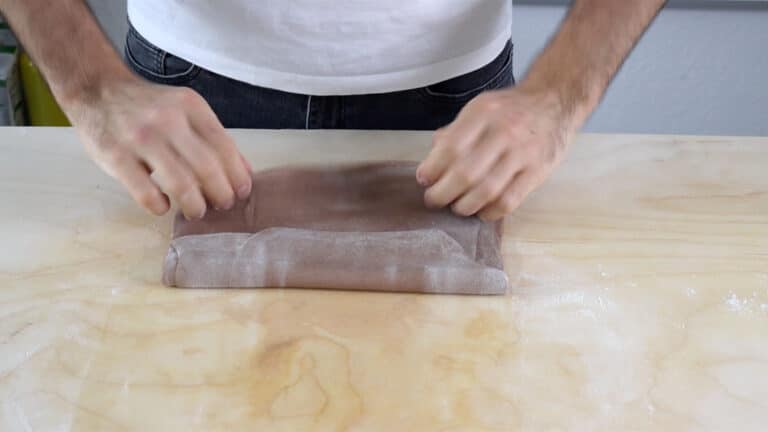
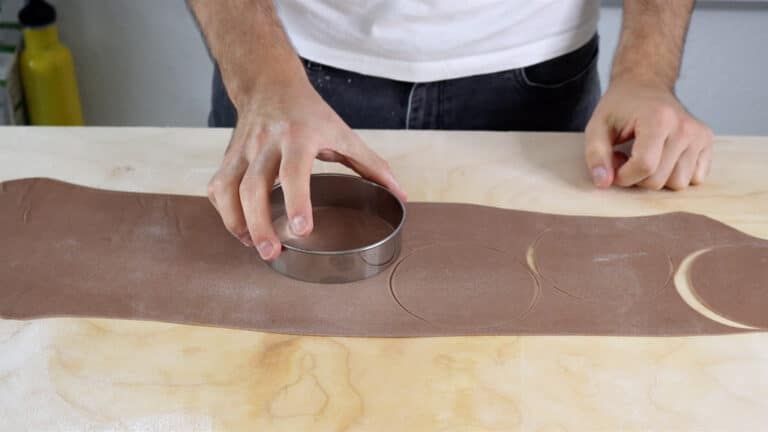
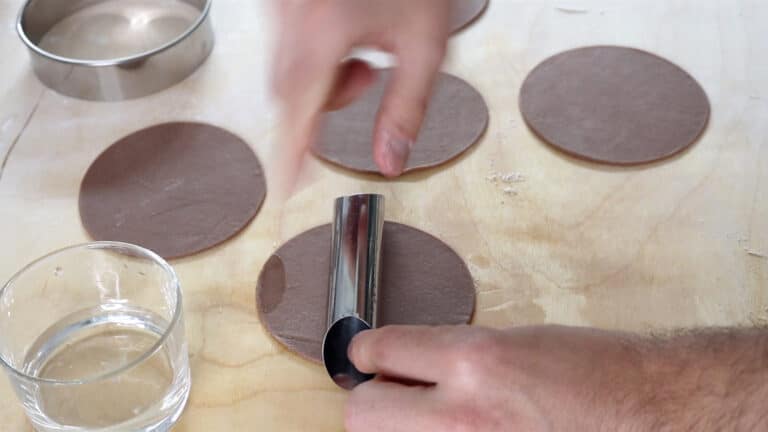
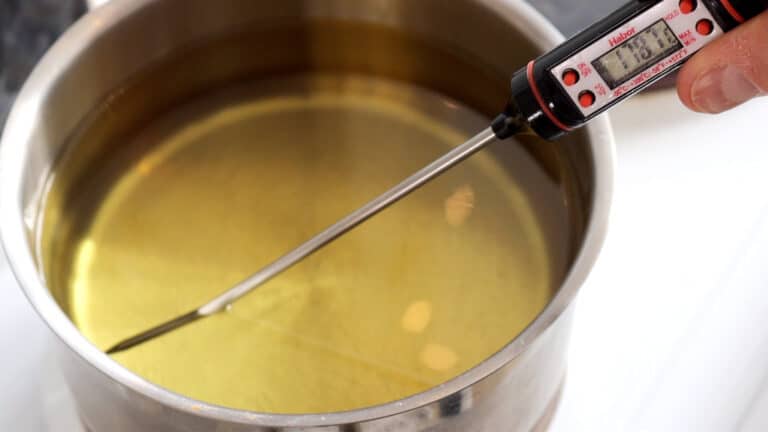

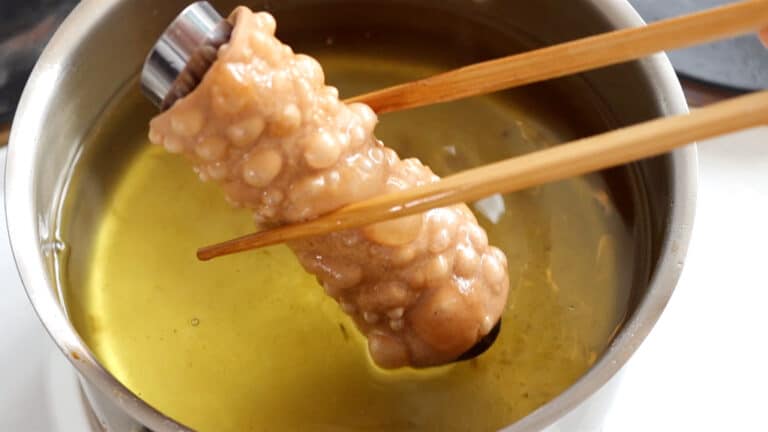
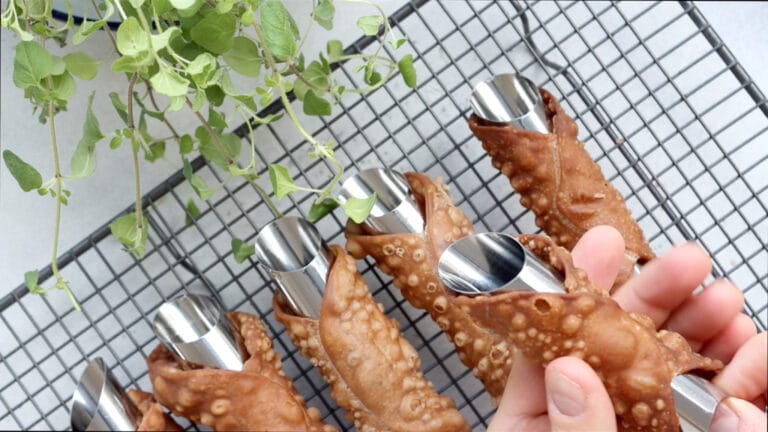
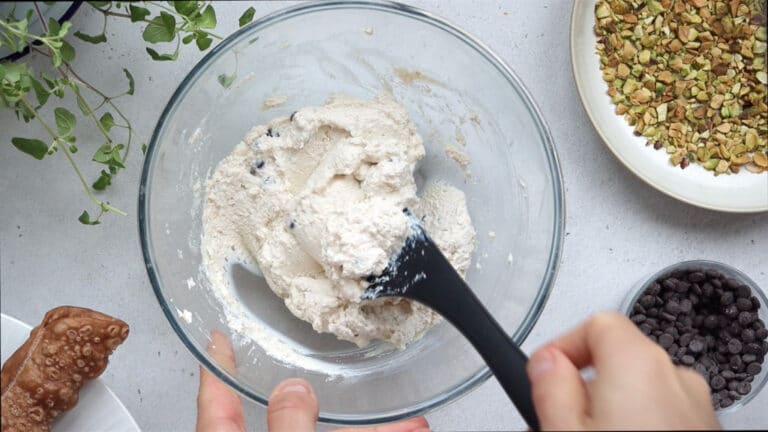
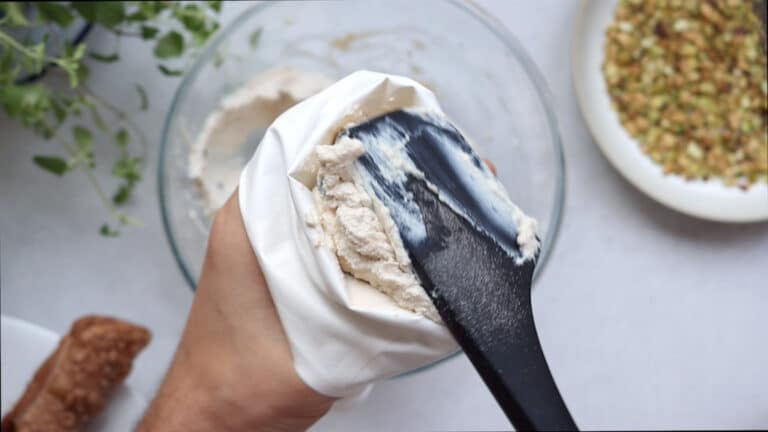
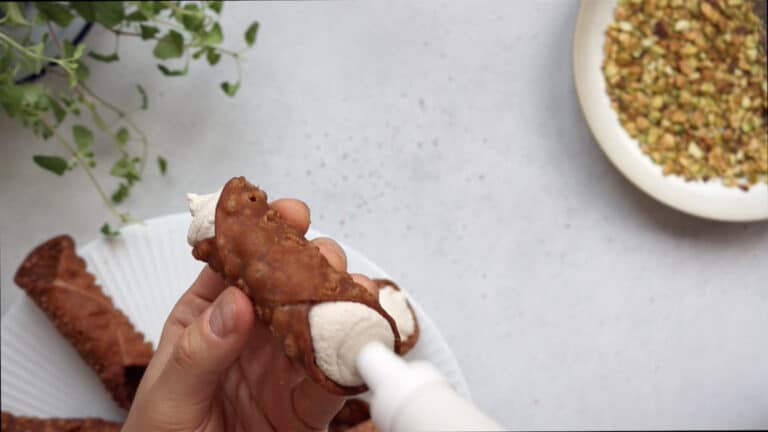

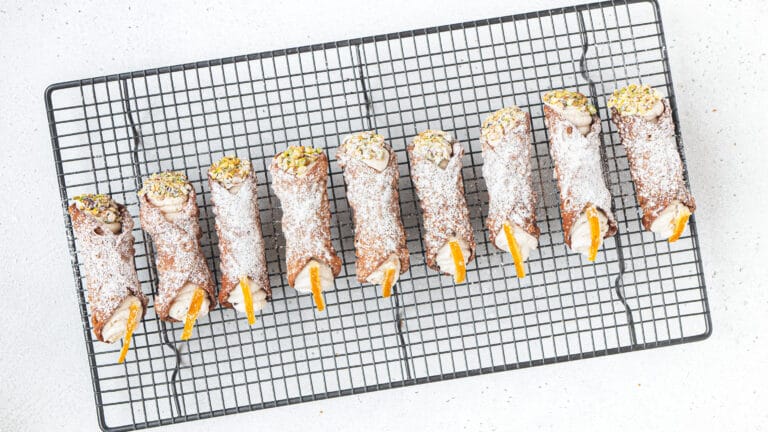
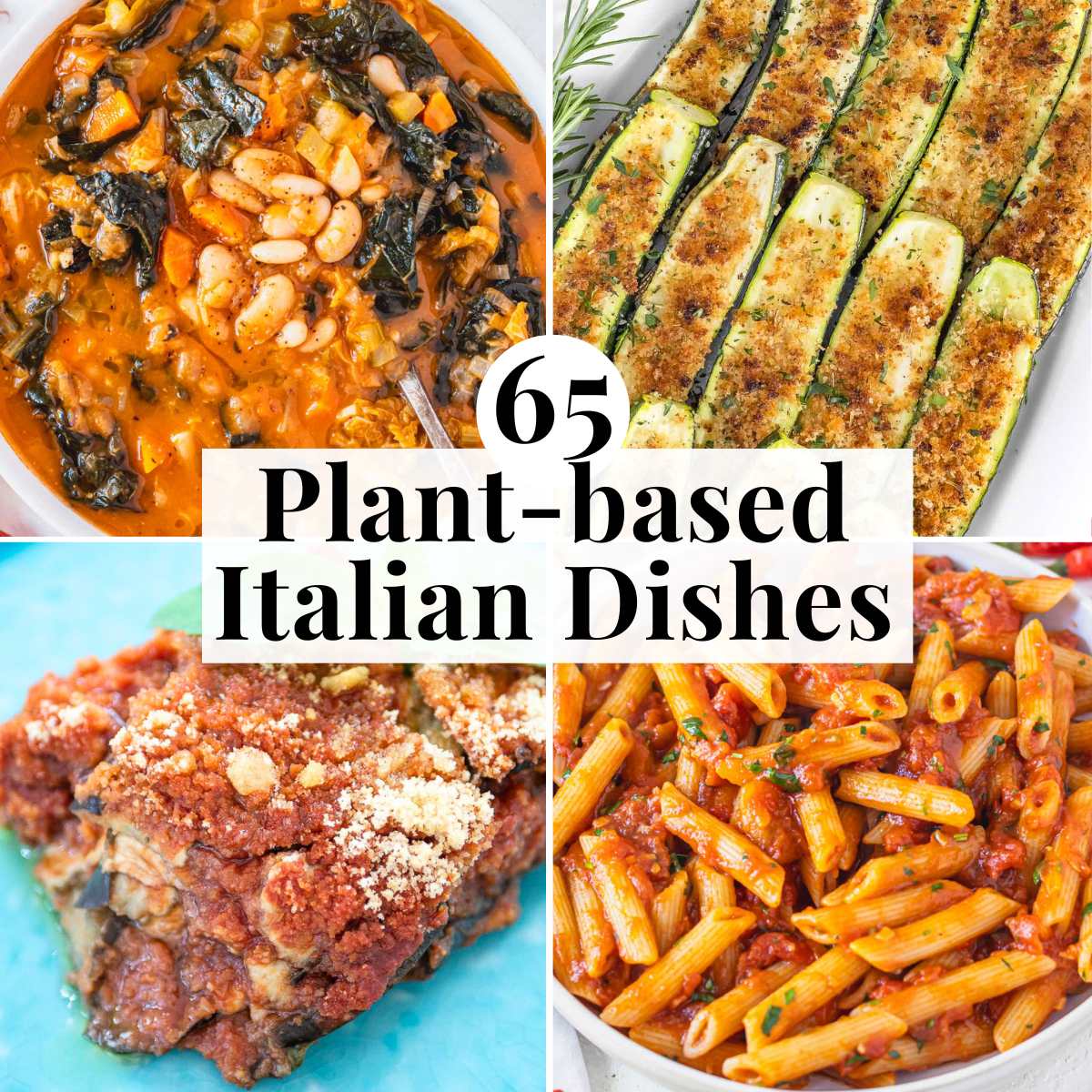
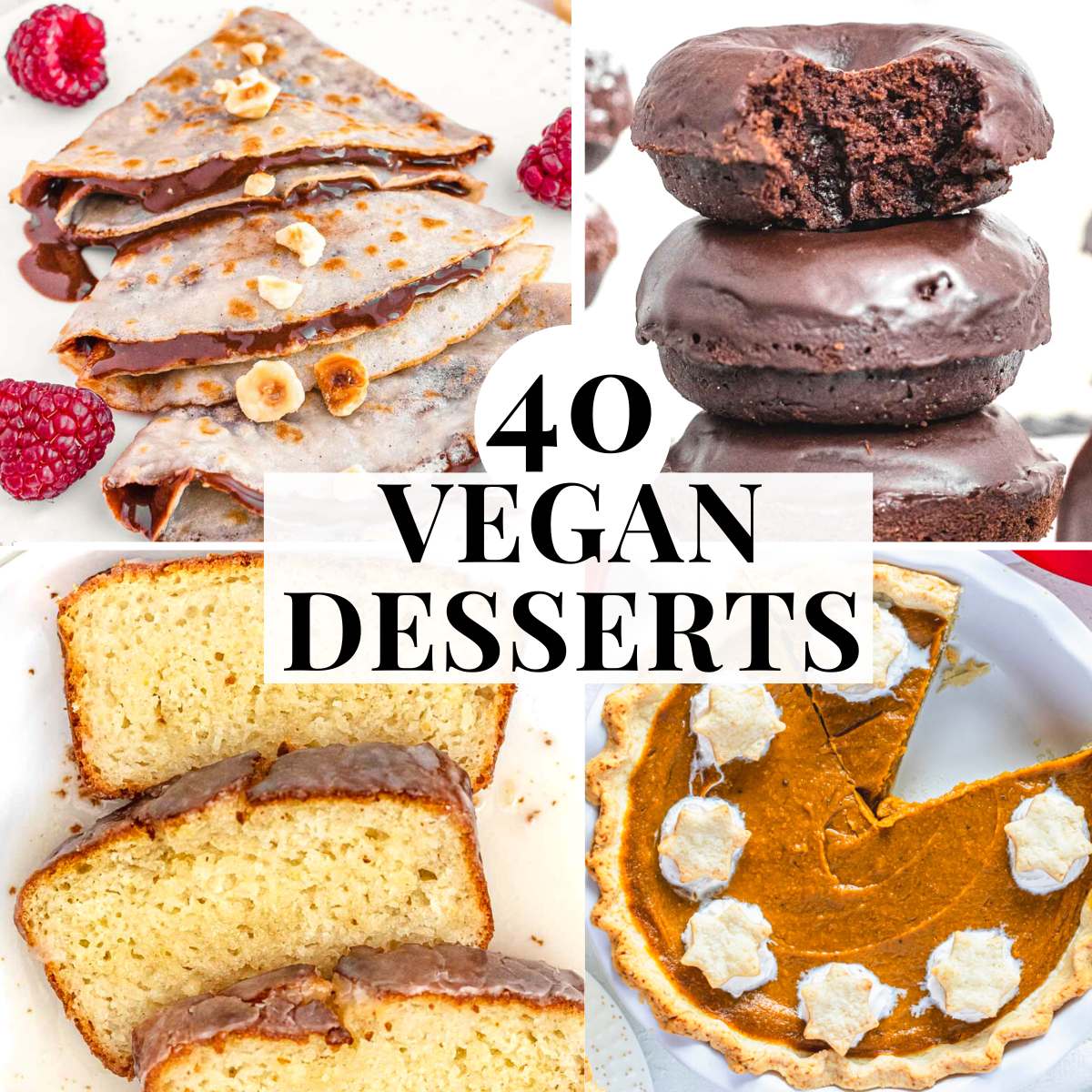
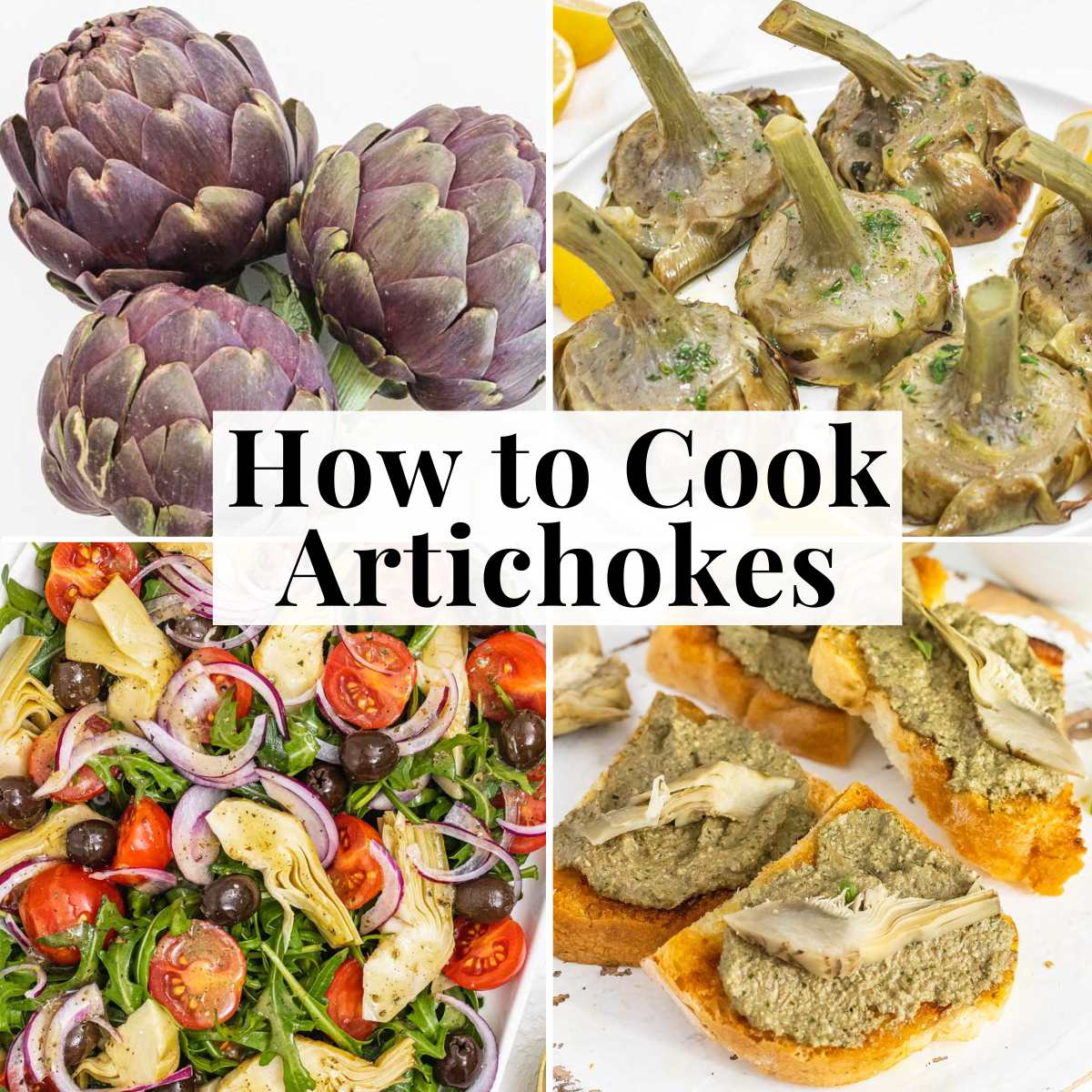

Hello! Should the butter be melted or just softened before adding it to the shell mixture? 🙂
Hi Nicole, thanks for your question. You can add the butter just softened 🙂
Great, thank you for your reply! Can’t wait to make them 🙂
So happy to discover this recipe. Everything I’ve seen (here in the US), whether a recipe, store-bought, or from a restaurant, has been made with vegan cream cheese, a homemade cashew base, or something else even more off-base, and is nowhere close to what I would consier remotely authentic. I have Sicilian family and grew up with fantastic homemade cannolis, and so I was always very picky about them, even before going vegan. Cannot wait to try this. They made theirs with a combination of ricotta and marscapone but I am still very optimisitc that this will resemble my childhood memories.
Glad you like this recipe, Cari. I tried to be as close to the real cannolis as possible 🙂 Let me know how they turn out 🙂
Hello Nico and Louise, I have not tried this receipe yet but I am so excited to find it and can not wait to try it (in fact I’m just getting all the ingredients together right now). I am vegan and Cannoli is one of the things that I have missed the most. As a child I remember all the Nonne would get together and make hundreds of Cannoli for weddings, christenings, birthdays…. They would make both ricotta and custard (chocolate and vanilla) and would flavour with Strega.
I was hoping I could use your custard recipe as a filling for the Cannoli?
Either way thank you for your amazing recipies. You guys are brilliant creating this fantastic food.
Suzanne
Hi Suzanne, thanks so much for your message. It makes us very happy. You can definitely use the custard (any of them, pistachio, chocolate, vanilla, lemon, or coffee) to fill the cannoli. I hope you are able to recreate some of your childhood flavours 🙂
I am wondering if I can use the cannoli filling recipe as a cannoli dip to serve with some waffle cone pieces. Can I make the cannoli filling, will it keep in the fridge for a day or 2?
Hi Karen, absolutely. It keeps for a couple of days in the refrigerator and it’s perfect as a dip with waffle cones. Just keep it in an airtight container or wrapped well. Thaaanks 🙂
Hi! I came across your recipe. I was wondering if anyone had success without soy milk? We have soy and dairy allergies and looking to make some.
I’m rating 5 stars even though I haven’t tried this yet cause it looks delicious. I have a question, can I use pea milk like Ripple for example instead of soy milk? If I have to use soy milk I will, nothing against it, I just never use it.
Hi Heather 🙂 Thanks sooo much. You can use pea milk instead of soy milk in most preparations. BUT…I actually haven’t tried to make RICOTTA with pea milk (I would love to, but it’s really hard to find where I live) so I am not sure if it curdles the same way as soy.
We found that the best result for making ricotta is with a soy milk that is as natural as possible, and with the highest percentage of soy you can find (from 8% and up is best). Also, it’s best if the soy milk doesn’t have stuff added to it, like B12, calcium, sugar and other flavouring agents.
So, if you try to make ricotta with pea milk, I’d say use one that is as natural as possible. And if you try pleaseee let us know if it works.
Thanks again 🙂
Hi!
We would like to try this recipe. We unfortunately have a diary and soy allergy in our household. Have you tried to make these with oat milk?
Thank you!
Hi Monique,
Thanks for your message.
We’ve tried making the ricotta with other plant milks (coconut, almond, cashew, rice, pea, oat), and it did not curdle up, unfortunately. Thus I cannot advise on a soy-free ricotta recipe for now, BUT we are working on cashew ricotta these weeks, and we will publish it, and add variations to this recipe, as soon as it’s satisfying.
Sorry I cannot be of more help for now – I wish you and your family an amazing Sunday.
Kindest,
Louise
Hi Just a quick comment on the various milks people asked about. Ripple (pea milk) and Flax milk (with protein) will curdle and can be used. As long as it has the protein in it, it will work for this recipe. I’ve experimented with which ones curdle and don’t and it does require the plant milk to have the proteins. I’ll be making this recipe tomorrow using Ripple Pea milk.
Hi KJ, that’s very valuable feedback, thanks so much for your input!
This is AMAZING! I’m so grateful to you and Louise for creating this site. Your commitment to kindness and making the world a better place – without any sacrifice on our parts because everything is so delicious – is helping to eliminate the pain and suffering of animals, our earth and our bodies. I love the attention to presentation and flavors that make every dish so appealing – it is helping win over the nonbelievers! I have tried to make vegan cassata cake without great results, and I’m wondering if you think the cannoli filling in this recipe would work well. I’d love any helpful tips! Thank you in advance ☺️
Angela thank you soo much for the kind words. We are really happy when other people really get what we are trying to do. It’s really not just recipes 🙂
The filling for the cassata is similar to cannoli, so yes, our filling should work. But make the ricotta with lemon juice instead of vinegar, it has a milder flavour 🙂 Hopefully we’ll be able to make vegan cassata soon.
Thanks again 🙂
Sorry autocorrect changed it to perfetto…..PERFETTA!
Since becoming plant-based, I thought cannoli were out of my life. Such a great recipe!! Terrific! Thank YOU for all the time and effort you put in to make this recipe! La crema è perfetto!
Aww…thanks so much Nicci for your amazing comment. It really made us smile 🙂 We are very happy you like the cannoli and the crema 🙂
❤️🌱❤️
Perfecto! My husband loved them and they were just like my Italian father used to make. Buon Natale!
Thank you for stopping by and leaving a comment Marion 🙂 Happy you both enjoyed the cannoli! Buon natale 🙂
Hello I’m so curious about this recipe! Any chance it can be made with gluten free flour?
Hi A, happy the cannoli recipe tweaked your interest! I have never tried making it with gluten-free flour, so I honestly cannot say. If you give it a go, please let me know (since I am curious too about the result). Cheers, Nico
super!! ho l’acquolina in bocca. Devo provarli!!
I really wanted to like this recipe. I was gonna short cut with store bought shells, but wow…something went way wrong with the filling. I followed the directions to a T…even used a timer, but after sitting for the 10 min, it still looked runny. I let it sit another 5 min, but upon pouring it into the cheese cloth pretty much ALL of it ran through. Didn’t even have enough ricotta to fill one shell. Soooo disappointing. I’m a good cook, so blowing a recipe is not something I do, so I’d love to know what I did wrong. Help!
Hi Carol,
I’m very sorry the ricotta didn’t work.
I trust that you are a very skilled cook, lack of curdling is often due to one or two of these:
1. Boiling the milk: the hotter the milk, the easier the ricotta will curdle. So bring it to a boil and try to add salt and vinegar shortly after.
2. The higher the percentage of soy written in the ingredients list of the milk, the higher the yield of ricotta that you can get from that milk. Try to get soy milk with at least 6.5% of soy listed in the ingredients.
3. Vinegar. We recommend using vinegar over lemon juice.
We have done many tests, the optimal amount of vinegar is 40 grams of vinegar for every 1 Liter of soy milk (or 2.5 tablespoon for ¼ of a gallon), while that of lemon is about 60 grams of lemon juice for every 1 Liter of soy milk (or 4 tablespoon for ¼ of a gallon).
4. Soy milk over other plant milks. Other types of dairy-free milk that you find in supermarkets won’t work, stick to soy milk. You might have some success with homemade almond milk, but we still don’t recommend it, as it takes too much time, and we are all about easy recipes on this blog.
I hope this helps. Please let me know if you have any other questions and/or thoughts.
I wish you a wonderful Sunday!
Kindest,
Louise